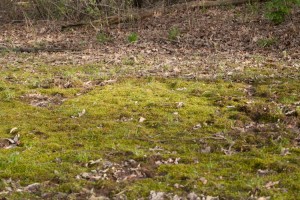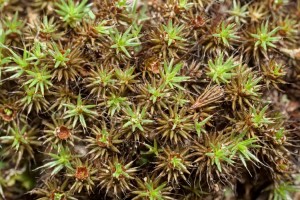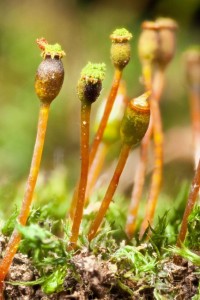Mosses are the most diverse group of bryophytes with a myriad of assorted characters, some which are characteristic of mosses in general and some that differentiate mosses from one another.
As with all plants, mosses have two stages of their lifecycle, one stage that produces spores, the sporophyte, and one stage that produces gametes (eggs and sperm), the gametophyte. When the sperm fertilizes the eggs, the resulting embryos grow into the sporophyte. Likewise, in a cyclic fashion, spores produced by the sporophyte grow into the gametophyte. In mosses, the sporophyte is attached to and dependent for food (not green and photosynthetic) upon the green gametophyte.

Habitat of the pale plait moss, Calliergonella lindbergii. The green mat on the forest floor is gametophyte.
In mosses, the gametophyte is green, has stems and leaves, and is the most noticeable stage of the lifecycle, i.e., the stage that you would generally observe as you take a walk in the woods.
The gametophyte stage is the stage the exhibits poikilohydry, the ability of mosses to dry to surrounding conditions without dying, and then begin metabolic activity when the environment becomes moist. To retain moisture as long as possible, mosses possess characters to prevent water loss.
One of the most conspicuous methods that mosses utilize to conserve water is to change the position of their leaves when the plants are dry versus wet. When dry the leaves often curl or press together, or move closer to the stem. With moisture, the leaves become wide spreading, allowing for maximum interception of light for photosynthesis. The change in leaf configuration between wet and dry conditions changes the entire look of the plant. You can imagine the aggregation this causes bryologists. They need to double their recognition skills to identify one moss species!
- The rounded tongue moss, Anomodon minor, when dry. Note that the leaves are mostly appressed to the stems.
- The rounded tongue moss, Anomodon minor, when wet, with leaves spread away from the stems.
- Dry plants of the bristly haircap moss, Polytrichum piliferum, showing leaves that are upright and closely erect with long white hairs at the tips. The white hairs reflect light to help prevent water loss in the plants.
- Wet plants of the bristly haircap moss, Polytrichum piliferum, showing the leaves widespread.
- Dry plants of Barbula unguiculata from a limestone fence. Note that the leaves are curled around the stem.
- Wet plants of Barbula unguiculata. Note that the leaves have uncurled and are spreading.
Variation in characters of the gametophyte often differentiates groups of mosses from one another. For example, mosses are either acrocarpous, upright plants that produce the sporophyte at the apex of the plant,
… or pleurocarpous, branching plants that bear sporophytes on side branches.
The sporophyte is usually composed of a stalk with a sporangium at the tip. Sporangia are the containers that produce spores, and vary in structural appearance between major groups of plants. In mosses the sporangia are round structures that are usually attached to a stalk, with the stalk attached to the gametophyte.

The knothole moss, Anacamptodon
splachnoides, with leafy green gametophytes and sporophytes composed of a brown stalk and sporangium attached.
Occasionally the stalk is very short or vestigial, causing the sporangia to be nestled within the leaves of the gametophyte.
The apex of the sporangium possesses a cap that protects the spores until they are fully developed and ready for dispersal. Underneath the cap is the beautifully intricate part of the moss sporangium, the peristome. The peristome is a ring of ornamented teeth around the opening of the sporangium that helps to disperse spores into the air stream by curling in and out of the sporangium as the humidity changes.
- Sporangia of Callicladium haldanianum with the caps still attached. Underneath the caps are the peristome teeth.
- Peristome teeth of Callicladium haldanianum after the cap has fallen off. Note that the peristome has two layers, the inner layer pointed outward and the outer layer curled inward at the tips.
- Sporangia of Aulacomnium heterostichum with two rows of peristome teeth at the top.
- The knothole moss, Anacamptodon splachnoides. The upright stalks with brown elliptical sporangia releasing green spores.
Sexual reproduction in plants, the production of gametes and spores, results in genetic variation in the offspring, but it is not the only means of reproduction in mosses. Asexual reproduction, the production of clonal propagules that are exact copies of either the gametophyte or sporophyte, occasionally occurs on moss gametophytes.
- Plants of Syntrichia papillosa with clusters of light green asexual propagules in the center of the leaves.
- Plants of the ribbed bog moss, Aulacomnium palustre, with stalks that have a group of asexual propagules at the tip.
- Plants of Tetraphis pellucida showing asexual propagules inside a cup-like formation of leaves.
- The oil spill moss, Platygyrium repens, produces angular, asexual propagules at the tips of the stems.
What does it mean to be a moss? Small, intricate, and full of wonderful variation!
About the Author: Dr. Cynthia Dassler is Curator of Cryptogams (small plants that produce spores) at The Ohio State Herbarium (OS) in the Department of Evolution, Ecology and Organismal Biology.
All photos courtesy of Bob Klips.
















